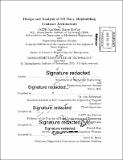Design and analysis of US Navy shipbuilding contract architecture
Author(s)
McCoy, Kathleen Marie, LCDR
DownloadFull printable version (10.18Mb)
Alternative title
Design and analysis of United States Navy shipbuilding contract architecture
Other Contributors
System Design and Management Program.
Advisor
Eric Rebentisch and Joe Harbour.
Terms of use
Metadata
Show full item recordAbstract
Contracting for US Navy ship procurement is complex due several factors such as budgetary and political concerns, sole or near sole source environments, and long lead-time construction. In the current climate of shrinking budgets, it is especially important to set programs up for financial success. One potential area for cost management improvement in acquisition programs is with the initial contract and incentive structure. If shipbuilding contracts could be described in engineering architectural terms, then perhaps that architecture could provide better clarity of contract options. Further, if contracting can be described as an engineering architecture, then perhaps that architecture could be optimized for a given result. These are the central questions of this thesis. To answer them, interviews were conducted with several experienced individuals from both industry and the government. Additionally, past shipbuilding contracts in both the US and Canada were examined. These insights were then used to form a contract architecture concept in accordance with the Tradespace engineering paradigm. From the concept definition came the design vector definition which included variables such as shareline definition, incentives, and contracted profit percentage. The tradespace was then populated by manipulating the design vector parameters. The Palisade tool [at]Risk was used to conduct the design vector manipulation and tradespace population. [at]Risk is an excel plug in that allows uncertain variables to be defined by probability distributions. The tradespace of contract outcomes was then evaluated against utilities such as cost, profit, and risk. Although the factors affecting the contracting environment are complex, and not all are modeled, quantitative modeling allows the architect to roughly evaluate different approaches, vice just basing the contract on past models. It also gives the government the ability to check whether shipbuilder furnished predicted costs are reasonable for a given contract structure.
Description
Thesis: Nav. E., Massachusetts Institute of Technology, Department of Mechanical Engineering, 2015. Thesis: S.M. in Engineering and Management, Massachusetts Institute of Technology, Engineering Systems Division, System Design and Management Program, 2015. Cataloged from PDF version of thesis. Includes bibliographical references (pages 92-95).
Date issued
2015Department
System Design and Management Program.; Massachusetts Institute of Technology. Department of Mechanical Engineering; Massachusetts Institute of Technology. Engineering Systems DivisionPublisher
Massachusetts Institute of Technology
Keywords
Mechanical Engineering., Engineering Systems Division., System Design and Management Program.